This spelt brioche bread is slightly sweet, soft, buttery and amazingly delectable.
After your first bite into this spelt brioche bread, you will definitely be wanting more. If you are anything like me, you will be gathering up every last crumb. This spelt brioche bread definitely takes a little bit more time to make than other types of bread, but I can guarantee you that it will be well worth the effort. This brioche bread served with some butter, jam and a delicious coffee will have you dreaming about visiting a French Café on the banks of the Seine river.
What is brioche bread?
Brioche bread is a bread of French origin. It is made on the same basis as traditional bread, but it has butter, eggs and milk added which adds to its richness and gives the bread its soft, tender crumb. Often brioche bread also has the addition of sugar, which gives it a slightly sweet flavour.
Brioche bread makes a really great substitute for traditional bread in French toast and delicious bread & butter puddings.
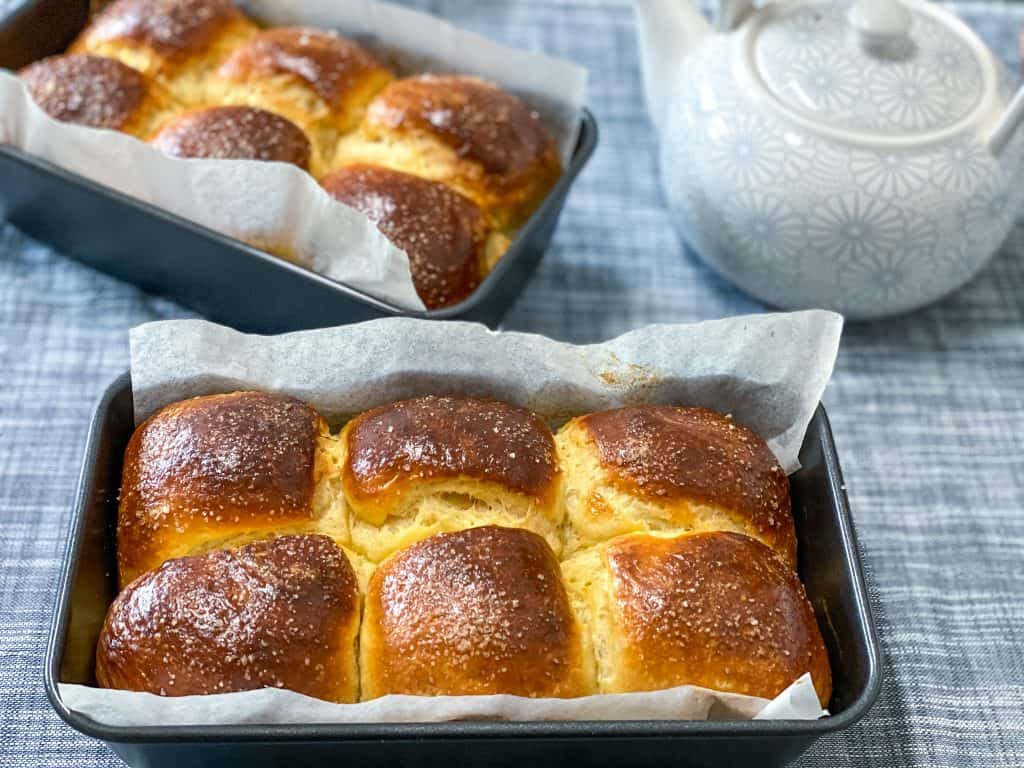
What is spelt?
Throughout my recipes, you will find that many of them contain Spelt flour instead of the traditional all-purpose flour.
Spelt is an ancient grain which is a subspecies of wheat that also contains gluten. It has been around for a really long time even dating back to biblical days where it is mentioned in the book of Exodus. Just like traditional flours, spelt comes in two varieties: white and wholewheat. Spelt is really an amazing flour as it can be substituted at a ratio of 1:1 with all-purpose flour. It is my go-to flour as I and a few others in my family struggle with wheat sensitivity, and I find this to be a great replacement.
Here are some other recipes where I use Spelt flour: Spelt Rolls, Spelt Shortcrust Pastry and Date, Walnut & Banana Loaf
What is Xanthan Gum?
Xanthan Gum is a food additive, that is produced through a fermentation process. It is used largely in the food industry as it is an effective thickening agent and stabilizer to prevent ingredients from separating. It also adds stability to products, especially gluten-free baked goods.
Xanthan gum provides elasticity and stickiness in doughs and batters. Flours that have low levels or the absence of gluten, need something that acts as the binding agent for the flour, assists with holding moisture, and helps give the baked good structure, therefore ensuring that they do not fall apart
When baking bread or dough-related products with spelt flour, from my experience, I really find that adding Xanthan Gum to the recipe improves the stability of the product, and results in a lighter texture and crumb.
Helpful hints before beginning…
- A stand mixer with a dough hook is highly recommended for ease because the dough has a soft consistency.
- Ensure that the butter and eggs are at room temperature.
- Ensure that the milk is lukewarm and not hot (Hot milk will kill off the yeast).
- Do not be concerned if the dough is soft and sticky because that is exactly what you are looking to achieve. Please do not add more flour.
- Place the dough in the fridge overnight as it will make the dough firmer and easier to shape. This resting period also improves the flavour of the brioche.
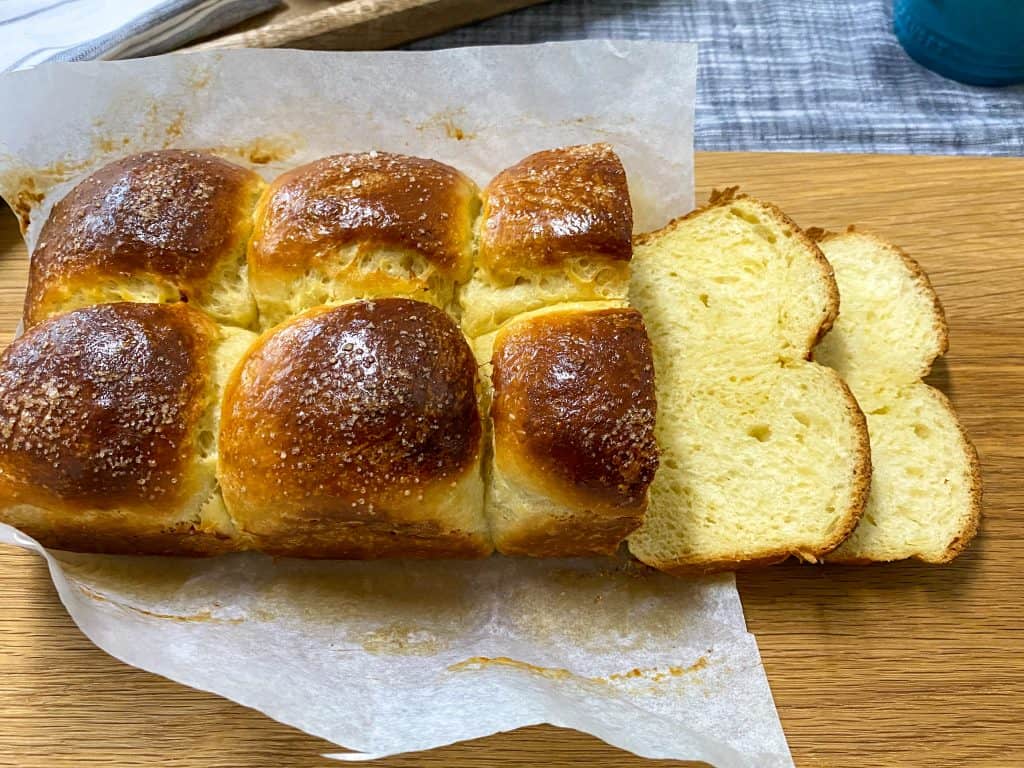
How to make a Brioche Spelt Bread
- Into the bowl of your stand mixer, add the yeast, sugar and lukewarm milk. Allow the mix to stand for 5 minutes and you will notice the yeast begin to foam, at this point you can add the eggs and mix until well combined.
- Add in the spelt flour, xanthan gum and salt. Knead for 5 minutes on low speed and then increase the speed and mix for a further 5 minutes or until you are left with a soft, smooth and elastic dough (Please note the dough will be smooth but it will be sticky to the touch)
- Add the softened butter pieces and knead for a further 7 – 10 minutes or until you have a soft and homogenous dough. The dough will be very slack after the butter is added but fear not because as you knead the dough, it will result in a soft, smooth and shiny dough. Once the butter is incorporated, stop kneading as overbeating will cause a compact brioche bread.
- Cover the dough with plastic wrap and allow to rise for 1 hour at room temperature, then place into the fridge overnight to rest.
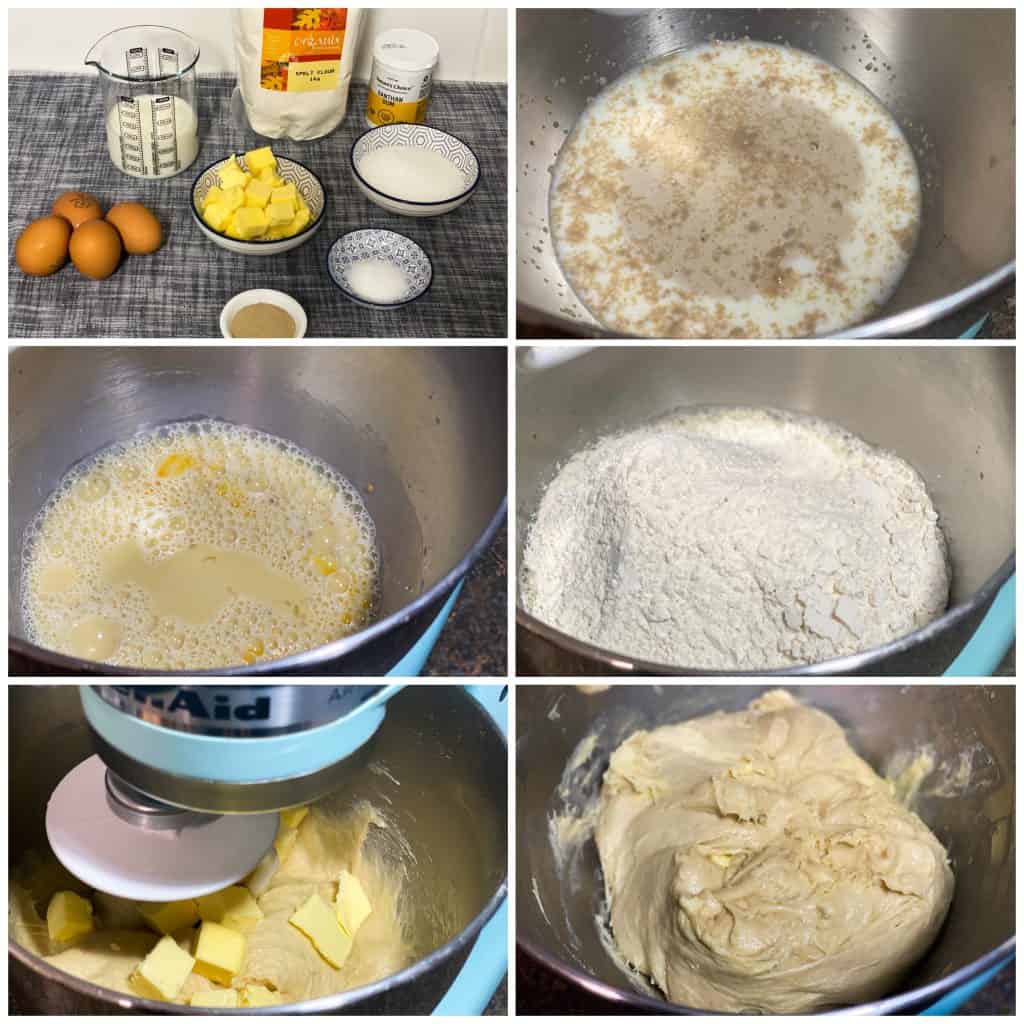
- Remove the dough from the fridge and turn it out onto a lightly floured surface. Deflate the dough and divide into 12 equal pieces, weighing about 98 – 100g each. Roll each piece into a smooth ball and arrange, seam side down, in the prepared loaf tins. Cover with a tea towel and let the dough rise in a warm place for 1½ – 2 hours or until the dough rounds have doubled in size.
- Preheat the oven to 180°C (356°F), do this about 15-20 minutes prior to baking the bread. Lightly beat the remaining egg and lightly brush over the surface of the risen brioche loaves before baking.
- Bake the loaves for 25 – 30 minutes or until golden brown. Cool for 5 minutes in the pans before transferring to a wire rack to cool completely.
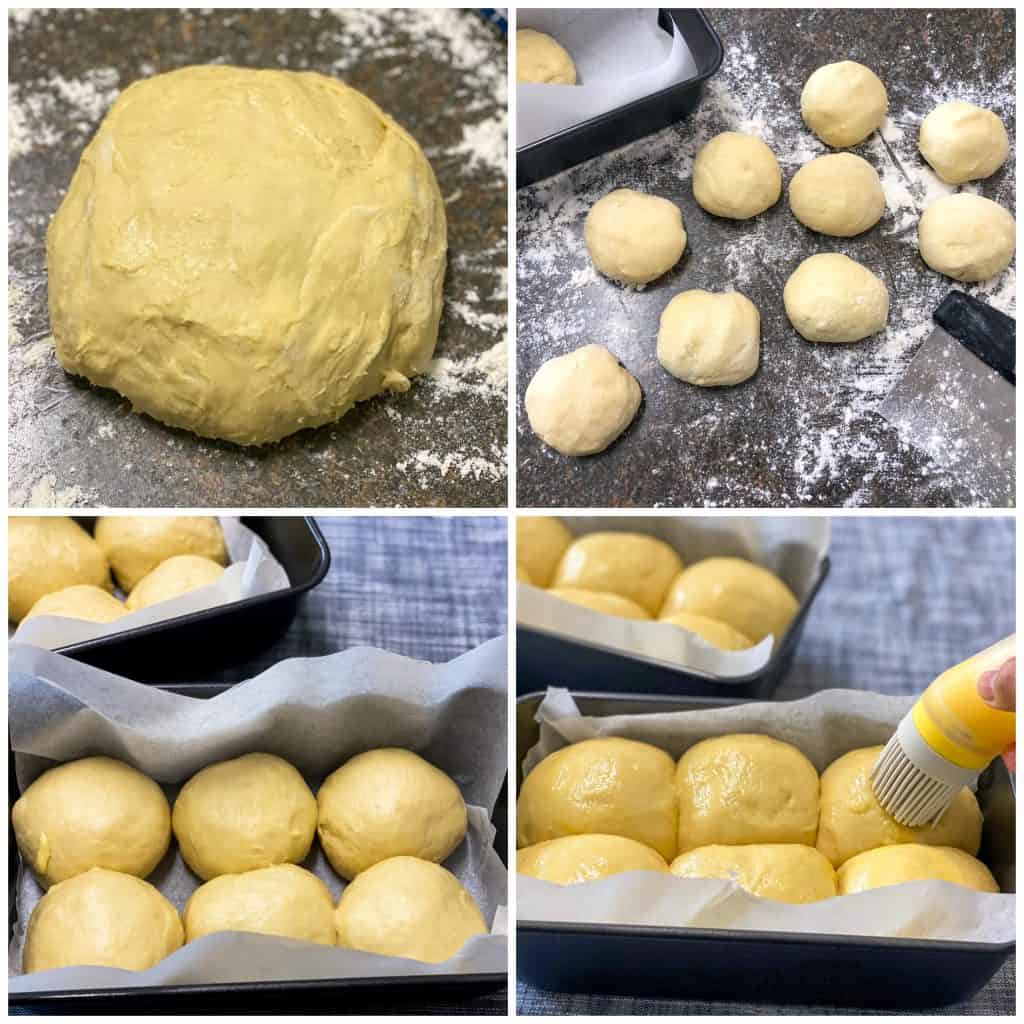
How to store the spelt brioche bread
Spelt brioche bread is best eaten on the same day that it is made but it can be stored in an airtight container for 1 -2 days. This bread recipe yields 2 loaves so I usually slice the loaves and place any leftovers into ziplock bags which I then freeze. You can freeze the bread for up to 1 month. When you are ready to consume, remove it from the freezer and allow it to defrost. This bread is wonderful when toasted as well and you can serve it with some butter, jam and/or cheese…please give it a try, you won’t be sorry.
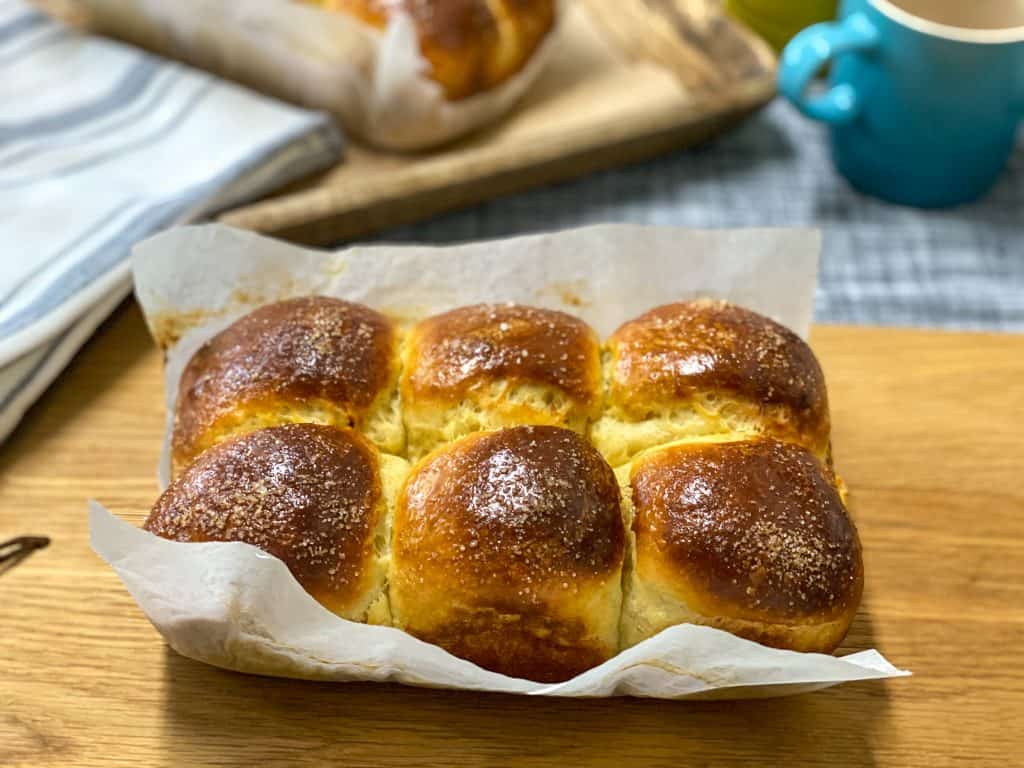
If you make this recipe I would love to hear about it!
Please leave a comment below.
Thank you for visiting, until next time, stay blessed
Spelt Brioche Bread
Ingredients
- 1 Cup Milk (Lukewarm)
- 10 Grams Instant Yeast
- ½ Cup Sugar
- 3 Large Eggs (+1 Egg for eggwash)
- 4 Cups Spelt Flour, White
- 1 Teaspoon Salt
- 2 Teaspoons Xanthan Gum
- 125 Grams Butter, cubed and softened
Instructions
- Into the bowl of your stand mixer, add the yeast, sugar and lukewarm milk. Allow the mix to stand for 5 minutes and you will notice the yeast begin to foam, at this point you can add the eggs and mix until well combined.
- Add in the spelt flour, xanthan gum and salt. Knead for 5 minutes on low speed and then increase the speed and mix for a further 7 – 10 minutes or until you are left with a soft, smooth and elastic dough (Please note the dough will be smooth but it will be sticky to the touch)
- Add the softened butter pieces and knead for a further 5 minutes or until you have a soft and homogenous dough. The dough will be very slack after the butter is added but fear not because as you knead the dough, it will result in a soft, smooth and shiny dough. Once the butter is incorporated, stop kneading as overbeating will cause a compact brioche bread.
- Cover the dough with plastic wrap and allow to rise for 1 hour at room temperature, then place into the fridge overnight to rest.
- Remove the dough from the fridge and turn out onto a lightly floured surface. Deflate the dough and divide into 12 equal pieces, weighing about 98 – 100g each. Roll each piece into a smooth ball and arrange, seam side down, in the prepared loaf tins. Cover with a tea towel and let the dough rise in a warm place for 1½ – 2 hours or until the dough rounds have doubled in size.
- Preheat the oven to 180°C (356°F), do this about 15-20 minutes prior to baking the bread. Lightly beat the remaining egg and lightly brush over the surface of the risen brioche loaves before baking.
- Bake the loaves for 25 – 30 minutes or until golden brown. Cool for 5 minutes in the pans before transferring to a wire rack to cool completely.
Notes
- Spelt flour can be replaced at a 1:1 ratio with all-purpose flour but then you will also need to remove the xanthan gum from the recipe.
Nutrition
This website provides approximate nutritional information for convenience and as a courtesy only.



21 comments
I found and made your recipe, I reduced the salt as my butter was salted this time. It was challenging for me not to modify and add more flour as this is a very sticky dough. I added 70 grams of organic raisins per loaf – tucked some into each roll as I shaped it. Used 3 tsp of guar gum (didn’t have xanthan). Turned out perfectly. Baked it in a 350F oven in Pampered Chef stoneware loaf pans. I’m just waiting for it to cool so I can cut into it.
So awesome that you made the recipe and trust that it turned out amazing! I really appreciate your feedback and love the idea of adding some raisins.
Just a note, the moisture content may differ depending on the altitude.
I look forward to trying this! Unless I have missed it, I don’t see any discussion or instructions regarding the loaf pans until you state to place each roll into “the prepared loaf tins”. So, more than one, I guess, and what size do you use? Do you find metal tins to work better than glass or stoneware?
Also, could this work easily if halved?
Thanks! I’ve started working with spelt this year. Always excited to find a new recipe!
That is fantastic news!! I make use of 2 loaf pans (23 x 13cm), and I add 6 rounds of dough into each pan. I definitely find it best to bake in metal pans and it allows for even heat distribution and it gives a wonderful end result.
You can absolutely half the recipe! Have fun baking and enjoy your new baking adventures with spelt flour. Many blessings
Made this recipe and it turned out great!! I used an instant rise pizza dough yeast. Also used less salt as my butter is salted. We are at a bit over 5000 feet and they rose great. The one thing I really missed for Thanksgiving was a good roll since I am allergic to wheat. But Spelt is great and we do lots of cooking with it. Thanks for the recipe – worth the wait.
This is such wonderful news and I am so glad that you can enjoy some spelt rolls this thanksgiving! Have a blessed Thanksgiving Day.
What temperature is this to be baked at? I am super excited to make it but realized I don’t know what temperature. Thanks!
So sorry about that! I did not realize that I forgot to add the temperature. I usually bake it in a preheated oven at 180 degrees Celsius (356 degrees Fahrenheit).
I will be updating the recipe shortly and thank you for letting me know!
Happy Baking!!
Fantastic! Thank you!!
For some reason although I did gluten free baking for years which always includes it, it never occurred to me to add xanthan or guar gum to spelt flour baking to get that extra fluffiness. Lovely brioche recipe. I made half as a brioche loaf and rolled out the other half, filled with butter, brown sugar, cinnamon, nutmeg and orange rind. Rolled up and cut to bake like cinnamon rolls. Super yummy!
Thank you so much for the feedback and I am glad that you enjoyed it! I will be giving your recommendation of the filling a try as that sounds super delicious!
Thank you for this recipe! Can we make it with whole spelt flour?
It is the greatest pleasure! For this recipe, I specifically used white spelt (Type 630), although I have interchanged other recipes with whole spelt flour and it worked well. If you give it a try, please let me know how it turns out. Happy Baking.
Hey karyn, you don’t say what size the baking tin, unless i missed seing it.Also i like to knaw if we may double the recipe for a bigger loaf- or extra rolls?
Hello Rose, I use 2 loaf pans (23 x 13cm), and I add 6 rounds of dough into each pan. I definitely find it best to bake in metal pans as it allows for even heat distribution and gives a beautiful end result.
You can absolutely double the recipe! Have fun baking and many blessings!
Can i make this brioche breads wth white wings plain gluten free all purpose flour?
Hi Rose, I have not personally tried making it with gluten free flour. If you do decide to give it a try, please let me know how it turns out.
Many blessings
Hi, I would love to make this recipe but I only have a scale for measuring, how much grams of spelt flour is needed for the recipe?
Hi Dana,
I am so sorry for the delayed response. I am making use of the Gut & Günsig spelt flour – Type 630. When I weighed it 1 cup = 145 grams of spelt flour. I trust this helps you.
Be Blessed!
Hi this dough is outstanding and very easy to make and handle. I have also rolled it out to about .75cm to 1 cm thick, spread with creme patisserie and any of cinnamon and brown sugar, or cardamom, raisins, and dried cranberries on top of the creme patisserie Cut in 2cm slices for pain au raisin style or 3-4 cm for cinnabun style. Same egg wash and second rise you describe. Pain au raisin needs room to spread on tray and bake 20 to 25 mins. 25 to 30 for the cinnabuns Any way you finish it this brioche dough is delicious.
Hi Catherine,
I am so glad to hear this and thank you for your feedback, it really means so much. The adjustments you made to the recipe also sounds delicious and I will be giving this a try as well 😃
Loads of blessings